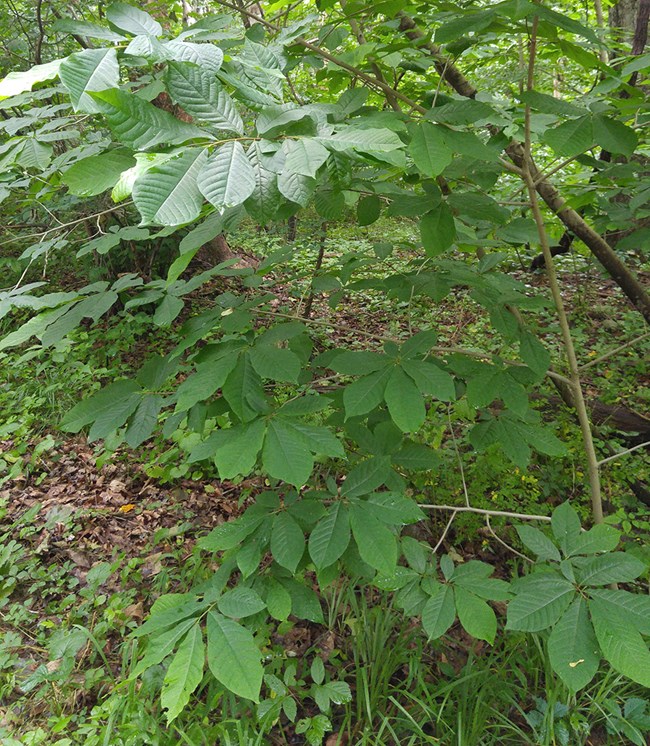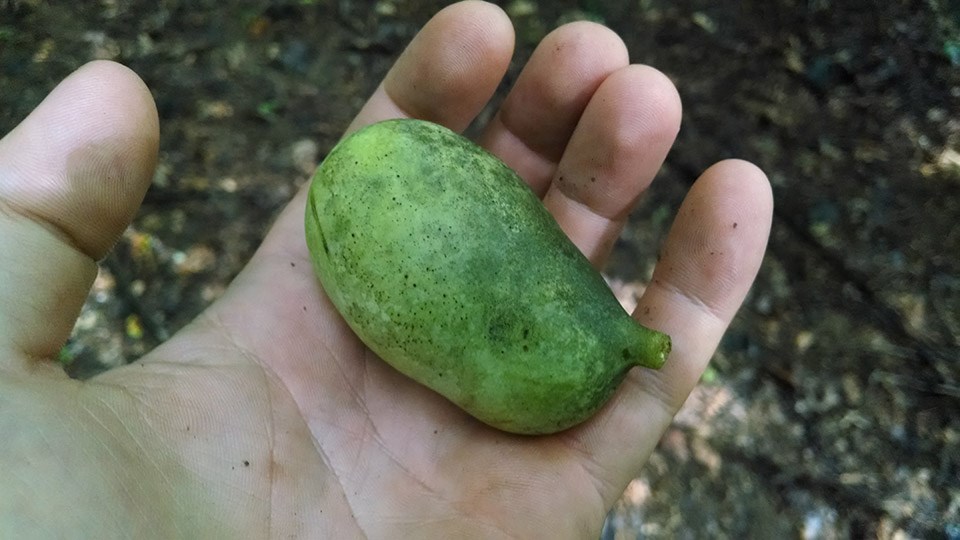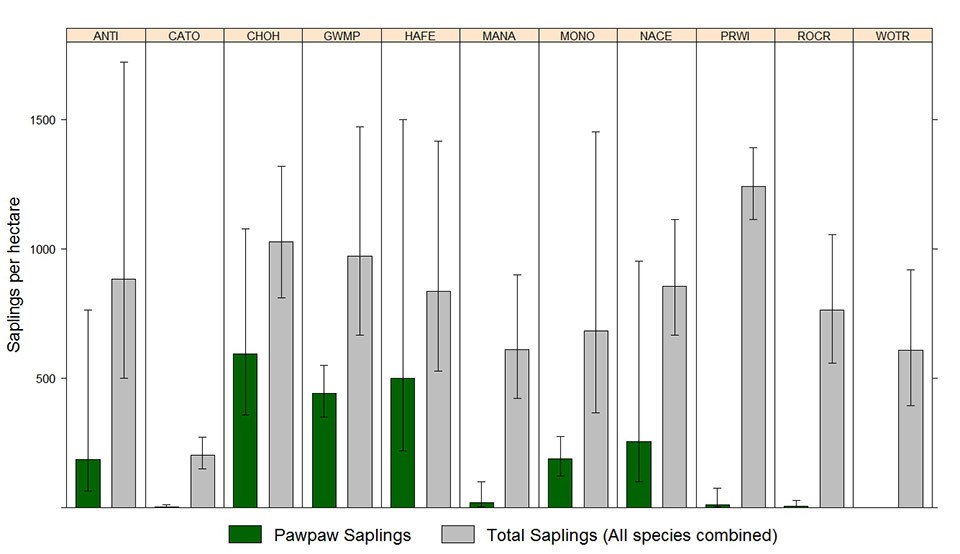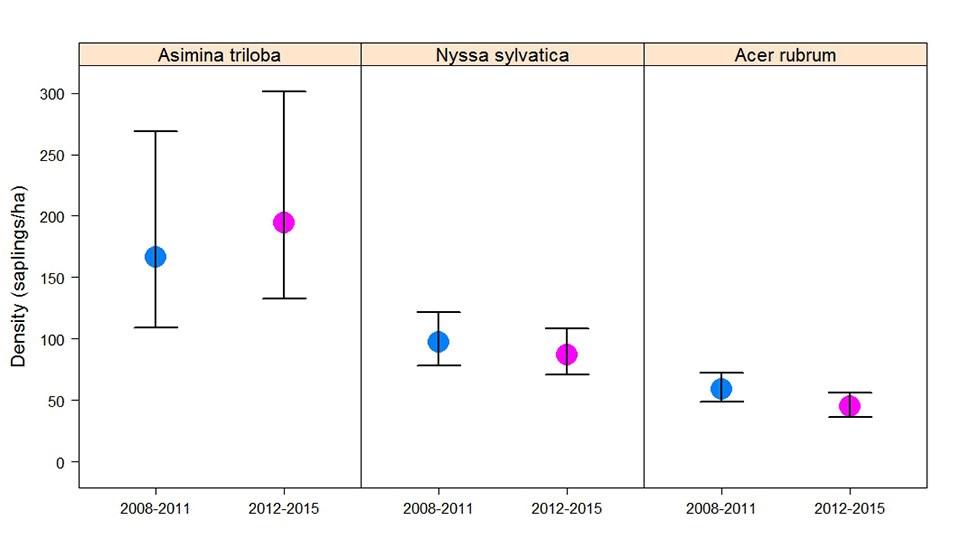Article
Pawpaw: Small Tree, Big Impact
By Elizabeth Matthews, Botanist for National Capital Region Network, Inventory & Monitoring program

NPS
Fruit

NPS/Brolis
NCR Parks with Many Pawpaws
While NCRN forest monitoring shows pawpaw to be the most common sapling in the region, some parks have many more pawpaw saplings than others (Figure 1). Pawpaw is the most common sapling species in C&O Canal (CHOH), GW Memorial Parkway (GWMP), Harpers Ferry (HAFE), and National Capital Parks - East (NACE), and ranks as the second most common sapling species at Antietam (ANTI), and Monocacy (MONO). This distribution is likely a reflection of the amount of preferred pawpaw habitat in each park, but may also be related to other ecological processes.
Habitat Expansion & Understory Domination
In recent decades, naturalists have noted the expansion of pawpaw from well-drained, lowland habitats into drier, upland forests. This phenomenon appears to be driven, at least in part, by patterns of deer browse. Deer find pawpaw foliage unpalatable and, therefore, avoid browsing pawpaw seedlings and saplings. Instead, they preferentially browse species such as spicebush (Lindera benzoin), oaks (Quercus spp.), red maple (Acer rubrum), and blackgum (Nyssa sylvatica). Deer avoidance of pawpaw is evident in NCRN forest data. Out of 2,480 saplings recorded in the most recent sampling period, 27% showed signs of deer browse. The browse rate is strikingly different for pawpaw (which represents 21% of all saplings) with less than 1% showing signs of deer browse and greater than 99% being browse-free!This deer behavior benefits pawpaw in two ways. First, small pawpaws don’t need to allocate energy to recovering from browse, and instead can put that energy towards growth and reproduction. Second, frequent deer browse on sapling and shrub species preferred by deer suppresses the growth of these species, clearing the way for pawpaw. As a result, we might expect to see pawpaw becoming more common in forest understories that are heavily impacted by deer browse (which describes most NCR forests). Indeed, NCRN’s
forest data show that pawpaw sapling density is increasing across the region, while the density of some deer-preferred species (e.g., red maple and black gum) is decreasing (Figure 2).
Another potential contributor to the success of pawpaw is the suppression of fires that were an important part of the disturbance regime in many eastern forests before European settlement. Pawpaw are not strongly fire-adapted (unlike other common canopy dominates, such as oaks), and they likely benefit from the lack of fire in contemporary forests.

Future Forest Canopy
What are the long-term implications of increasing pawpaw dominance in the forest understory? Although we don’t have a firm answer to this question just yet, we do know that the mix of tree species in the forest understory influences the long-term trajectory of the forest canopy. Many factors determine which saplings ultimately become canopy trees, but trees that do not show up in the sapling layer will never join the forest canopy.Similarly, species that are more common in the sapling layer have more potential to be represented in the canopy than those with fewer saplings. If pawpaw continues to become more common in the sapling layer at the expense of other species, we might expect it to one day dominate the tree canopy as well.
Pawpaw is a small tree species (some might even consider it a tall shrub), growing to a maximum height of 15m— considerably shorter than the species that currently dominate NCR forest canopies. The five most common forest trees according to NCRN monitoring data include tuliptree (Liriodendron tulipifera), red maple (Acer rubrum), American beech (Fagus grandifolia), Virginia pine (Pinus virginiana), and white oak (Quercus alba). All of these
grow to 30m or more. If deer populations remain high, the forest canopy height may decline over time, particularly in areas where pawpaw is the only understory species available to replace dead or dying canopy trees. Or, perhaps the forest canopy would become patchier, with short patches dominated by pawpaw and tall patches dominated by other species that are represented in the sapling layer of the forest (American beech, for example, is deer-browse resistant and the second most common sapling in NCR forests).
Interestingly, a similar phenomenon has been observed in over-browsed forests in central Pennsylvania. In these forests, the small, understory species striped-maple (Acer pensylvanicum) has become increasingly common in the forest understory over a 60-year observation period. At the same time, tree species that are capable of growing into the forest canopy have declined by 85% (Kain et al. 2011). Striped maple and American beech were found to make up 82% of all trees in the deer-browsed forests. The authors of this study speculate that these forests may experience unprecedented changes which will ultimately lead to a forest canopy dominated by only a few species that are resistant to deer browse. It is too early to tell if this is the future for NCR forests. For the time being, it is clear that deer-avoidance of pawpaw is contributing to its increased dominance in our understory, and while we may appreciate additional opportunities for fall fruit foraging, we hope it’s not at the expense of losing our mighty tree canopy!
Citations
Kain, M., Battaglia, L., Royo, A., and W.P. Carson. 2011. Over-browsing in Pennsylvania creates a depauperate forest dominated by an understory tree: Results from a 60-year-old deer exclosure.Tags
- antietam national battlefield
- baltimore-washington parkway
- catoctin mountain park
- chesapeake & ohio canal national historical park
- civil war defenses of washington
- fort dupont park
- george washington memorial parkway
- great falls park
- greenbelt park
- harpers ferry national historical park
- manassas national battlefield park
- monocacy national battlefield
- national capital parks-east
- piscataway park
- prince william forest park
- rock creek park
- wolf trap national park for the performing arts
- ncrn
- i&m
- asimina triloba
- pawpaw
- forest
- saplings
- forest succession
- deer browse
- herbivory
- natural resource quarterly
- fall 2016
